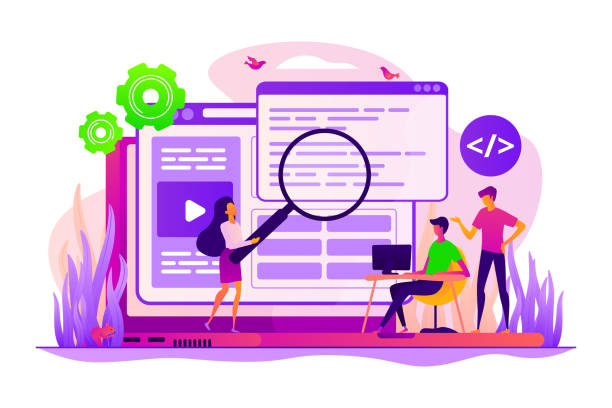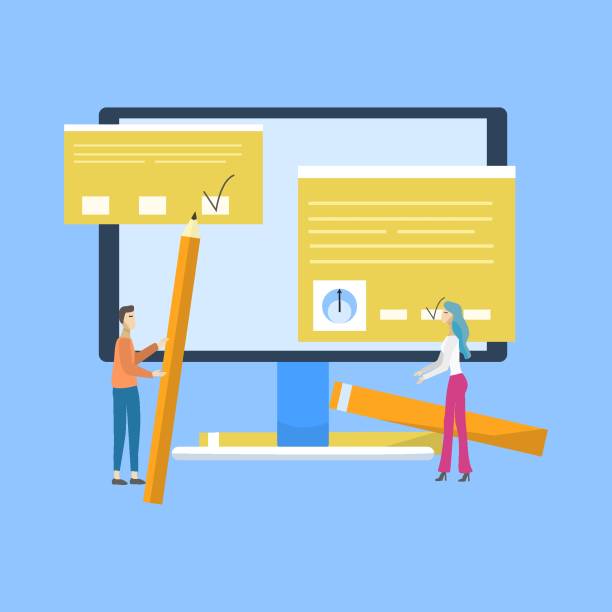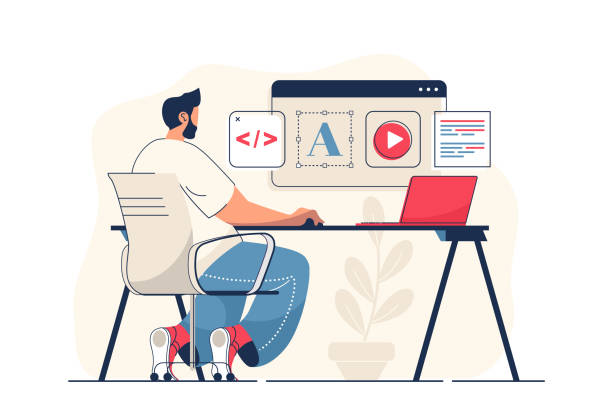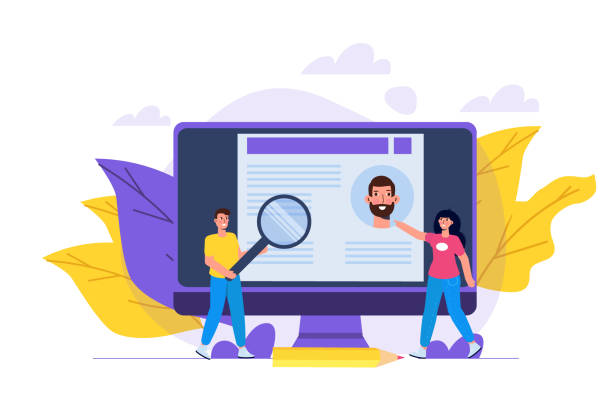Introduction to SEO-Optimized Website Design and Its Importance in Today’s World
![]()
In the current digital age, an online presence is vital for any business.
But merely having a website is not enough; it’s crucial that your website is seen.
This is where the concept of #SEO_Website_Design gains importance.
SEO-optimized website design means building a website that is not only attractive and functional for users but also understandable and favorable to search engines like Google.
The main goal of this is to #Increase_Traffic organically and achieve #Google_Ranking for keywords relevant to your business.
Without SEO, your website might get lost in the sea of digital information and never be discovered by your target audience.
This approach requires a combination of technical knowledge, content marketing, and a deep understanding of user behavior.
Many people think SEO is a post-design process, whereas for the best results, SEO principles should be considered from the very beginning of the website design phase.
A website with a proper structure, high speed, valuable content, and excellent #User_Experience has a higher chance of achieving top rankings in search results.
This section of the article provides an educational approach and explains why investing in a search engine optimized website is a smart and vital decision for survival and growth in today’s competitive market.
Further on, we will delve into more details about the key factors of an SEO-optimized website design.
Are you tired of your e-commerce website not generating as much revenue as it could? Rasaweb, specializing in professional e-commerce website design, solves this problem permanently!
✅ Increase sales rate and revenue
✅ High loading speed and unparalleled user experience
⚡ Get free consultation for e-commerce website design
Main Pillars of On-Page SEO in Web Design

On-Page SEO refers to all actions we take within the website itself to improve its ranking in search engines.
These actions are among the most important factors in SEO-optimized website design.
The first pillar is content quality and relevance.
Your content must be rich, accurate, unique, and address user needs.
Intelligent and natural use of relevant keywords in titles, body text, and subheadings is of high importance.
The second pillar is HTML tag optimization.
Title tags and Meta Descriptions should contain main keywords and be attractive to encourage users to click.
These elements are directly displayed in search results and play a vital role in the click-through rate (CTR).
The third pillar is image optimization.
Image size should be small to avoid slowing down page loading, and using appropriate Alt tags and titles for images that include keywords helps search engines understand image content.
The fourth pillar is a friendly URL structure.
URLs should be short, readable, and contain keywords relevant to the page.
This is not only beneficial for SEO but also improves user experience.
Finally, internal linking structure is also highly important.
Linking related pages within the website helps search engines better understand your website’s structure and distribute page authority among different pages.
Adhering to these specialized principles in the SEO-optimized website design process creates strong foundations for your website’s visibility in search results.
Technical and Infrastructural Aspects of SEO-Optimized Website Design

Technical aspects of a website are often overlooked but play a vital role in the success of an SEO-optimized website design.
Website loading speed is one of the most important factors; both users and search engines care about speed.
Slow websites will have lower rankings and experience higher bounce rates.
Optimizing codes (CSS, JavaScript), compressing images, and using content delivery networks (CDNs) can help improve speed.
| Technical Factor | Importance for SEO | Description |
|---|---|---|
| Page loading speed | Very High | Direct impact on user experience and ranking. Slow pages are penalized. |
| Mobile-friendliness | Crucial | Google indexes the mobile version first (Mobile-first indexing). |
| URL structure | High | Clean and meaningful URLs help search engines. |
| XML Sitemap | Medium | Helps crawlers find all important site pages. |
| Robots.txt file | Medium | Manages crawler access to parts of the site. |
| Use of HTTPS | High | HTTPS security protocol is a ranking factor. |
Mobile-Friendliness is another factor that Google greatly values.
Given the increasing use of smartphones for web browsing, your website should have a responsive design to display well on any device.
Also, using the HTTPS protocol is very important for your website’s security and user information, and Google also prefers HTTPS websites.
Creating an XML Sitemap and submitting it to Google Search Console helps search engines understand your website’s complete structure and correctly index all its pages.
The Robots.txt file also allows you to control search engine crawlers’ access to specific parts of your website.
All these technical aspects provide strong foundations for a professional and successful SEO-optimized website design.
Importance of Content Creation and Keyword Strategy in SEO

After implementing technical infrastructures, the backbone of any SEO-optimized website design is quality and targeted content production.
Content is king, and this phrase still holds true in the world of SEO.
Producing valuable content relevant to audience needs not only attracts visitors but also shows search engines that your website is a credible and reliable source.
Before starting content production, it is necessary to conduct comprehensive keyword research.
This research includes identifying the words your target audience enters into search engines to find products or services similar to yours.
Your keyword strategy should include both short-tail and long-tail keywords.
Longer keywords typically have less competition and more precisely indicate user intent, thus having higher conversion rates.
Your content should not only contain keywords but also answer user questions, solve their problems, and provide in-depth and practical information.
This is a guiding approach that helps users meet their needs.
Types of content can include blog articles, infographics, videos, podcasts, guides, and Q&A.
Regular content updates also show search engines that your website is active and dynamic, and its information is always fresh and relevant.
These important steps in your content strategy significantly impact improving your website’s ranking and increasing traffic.
Is your current e-commerce website not generating the sales you expect?
Rasaweb specializes in professional e-commerce website design!
✅ An attractive and user-friendly site aimed at increasing sales
✅ High speed and security for an ideal shopping experience⚡ Get free consultation for online store design with Rasaweb!
Link Building and Off-Page SEO for Increased Authority

Alongside on-page and technical SEO, Off-Page SEO plays a complementary role for a successful SEO-optimized website design.
Off-page SEO refers to all activities performed outside your website aiming to increase its Domain Authority and reputation in the eyes of search engines.
The most important aspect of off-page SEO is Link Building.
Receiving backlinks from credible websites relevant to your field shows search engines that your website is a reliable and valuable resource.
The more numerous and higher quality the backlinks, the more your website’s credibility increases in Google’s eyes, which helps improve your ranking.
However, it should be noted that not all links are equal.
High-quality links from highly authoritative and relevant websites are much more valuable than spammy or irrelevant links.
Link-building methods include creating high-quality content that others want to link to (Link Bait), Guest Posting on relevant websites, building relationships with influencers and requesting links, and using social media to promote content.
Activity on social networks and increasing Social Signals can also indirectly affect SEO, as popular content on social media often leads to natural links.
This specialized approach to link building is a long-term strategy that gradually increases your website’s authority, ultimately leading to better rankings in search results.
User Experience (UX) and Its Connection to SEO-Optimized Website Design

Perhaps at first glance, User Experience (UX) and SEO seem like two separate fields, but in reality, they have a very close relationship, and an excellent SEO-optimized website design is not possible without considering UX.
Search engines, especially Google, aim to provide the best and most relevant results to users.
Therefore, if your website has a poor user experience, even by adhering to all technical and content SEO principles, it probably won’t rank high.
User experience includes ease of navigation, loading speed, attractive visual design, content readability, and website responsiveness.
When users can easily find the information they are looking for, view different pages of the website without problems, and enjoy their visit, they spend more time on your site (Dwell Time).
This shows search engines that your content is valuable and helps reduce the Bounce Rate.
A high bounce rate indicates that users leave the site quickly after entering, which is a negative signal for SEO.
A website with excellent UX not only keeps users satisfied but also indirectly helps improve SEO ranking.
This is an important analysis that shows how investing in UX is, in fact, also investing in SEO.
Therefore, when undertaking SEO-optimized website design, you should always keep the end-user in mind.
Measuring Success and Data Analysis in Website SEO

After implementing the SEO-optimized website design strategy, the next crucial step is measuring and analyzing performance.
Without data, you cannot understand what works and what needs improvement.
Tools such as Google Analytics and Google Search Console are essential.
Google Analytics allows you to track website traffic, user behavior, traffic sources, and conversion rates.
You can understand where users come from, what pages they visit, and how long they spend on your site.
| Analysis Tool | Main Application | Trackable Metrics |
|---|---|---|
| Google Analytics | Tracking traffic and user behavior | Visitors, popular pages, bounce rate, dwell time, traffic sources |
| Google Search Console | Monitoring performance in search results | Keywords searched, clicks, impressions, click-through rate, indexing errors |
| Moz Pro / Ahrefs / SEMrush | Competitor analysis and link building | Domain Authority, backlinks, competitor keywords, SEO issues |
| PageSpeed Insights | Checking site loading speed | Speed score, Core Web Vitals (LCP, FID, CLS) |
Google Search Console provides vital information about how your website is seen in search results.
You can find out which keywords caused your website to appear, what the click-through rate is for each keyword, and whether search engines encountered any errors in indexing your pages.
Additionally, tools like Moz Pro, Ahrefs, or SEMrush can help you analyze competitors, review backlink profiles, and discover new opportunities.
Accurate analysis of this data allows you to optimize your SEO strategy, identify weaknesses, and emphasize strengths.
This analytical and guiding approach ensures that your efforts for SEO-optimized website design lead to tangible results and that your website is continuously improving.
Common Mistakes to Avoid in SEO-Optimized Website Design

On the path to achieving a successful SEO-optimized website design, there are some common mistakes that can render your efforts fruitless.
One of the biggest mistakes is ignoring keyword research.
Creating content without knowing what your audience is actually searching for is like shooting in the dark.
Another mistake is stuffing content with keywords (Keyword Stuffing).
While this method might have worked in the past, today search engines strongly penalize it and it can lead to your website being penalized.
Keywords should be used naturally and logically within the text.
Ignoring website loading speed is also a glaring error.
Today’s users are impatient, and a website that takes more than a few seconds to load will be quickly abandoned.
This not only negatively affects user experience but also directly harms SEO ranking.
Furthermore, many websites are still not responsive or have a poor mobile version.
Given that Google uses a Mobile-first indexing approach, this is a serious mistake that can prevent your website from being seen in search results.
Overlooking internal linking, producing duplicate or low-value content, and failing to regularly update your website are also common mistakes.
Some webmasters also forget to update XML sitemaps or submit them to Google Search Console.
These may not seem like headline news, but these mistakes are very common and destructive.
Continuous learning and staying updated with the latest changes in Google’s algorithms are crucial to avoiding these mistakes and ensuring that your investment in SEO-optimized website design is not wasted.
Are you frustrated with the low conversion rate of your e-commerce site? Rasaweb transforms your e-commerce site into a powerful tool for attracting and converting customers!
✅ Significant increase in visitor-to-buyer conversion rate
✅ Unparalleled user experience for increased customer satisfaction and loyalty⚡ Get free consultation from Rasaweb!
The Future of SEO-Optimized Website Design: AI and Algorithm Changes

The world of SEO is constantly evolving, and a sustainable SEO-optimized website design requires an understanding of future trends.
One of the biggest drivers of these changes is Artificial Intelligence (AI).
Google’s algorithms like RankBrain and BERT, and now MUM, all based on artificial intelligence, are becoming more complex.
These algorithms not only understand keywords but also truly grasp the meaning of phrases, user intent, and the overall relevance of content to the query.
This raises the question of how we can adapt to these changes.
The future of SEO is moving more towards providing an unparalleled user experience and comprehensive, in-depth content.
Voice Search is also growing and requires content optimization for natural language and longer, conversational questions.
Your content should be optimized not only for written keywords but also to answer voice queries.
Furthermore, Local SEO will become more important for physical businesses.
The emergence of AI also provides new opportunities for automating SEO tasks and data analysis.
However, human creativity and a deep understanding of the audience will remain irreplaceable.
Websites that can keep pace with these changes and focus on providing real value to users instead of trying to trick algorithms will continue to succeed in the future.
This analysis shows that SEO-optimized website design in the future will increasingly require a comprehensive and long-term perspective.
Local SEO and Its Role in Attracting Regional Customers

For many businesses, especially those with a physical location (such as restaurants, stores, clinics, etc.), Local SEO is a vital component of an SEO-optimized website design strategy.
Local SEO refers to the process that helps your business appear in local search results when users are looking for products or services near them.
For example, if someone searches for “coffee shop near me,” local SEO determines which coffee shops will be displayed in the results.
The first step in local SEO is to create and optimize your business profile on Google My Business (GMB).
Accurate and up-to-date information including business name, address, phone number, operating hours, and high-quality images are very important.
Also, collecting positive customer reviews on GMB and responding to them has a significant impact on local ranking.
Customer reviews not only help Google assess your business’s credibility but also build trust with potential customers.
In addition to GMB, ensuring NAP (Name, Address, Phone Number) consistency across all online directories (such as Yelp, various city maps, etc.) is also crucial.
This consistency signals to Google that your business information is legitimate and reliable.
Using local keywords in website content, creating separate pages for each location (if you have multiple branches), and implementing schema markup for contact information and address are other local SEO strategies.
Local SEO is a guiding approach for businesses that want to attract local customers and should not be overlooked in the SEO-optimized website design process.
Frequently Asked Questions
| Question | Answer |
|---|---|
| What is SEO-optimized website design? | Designing a website that is optimized for both users and search engines to achieve higher rankings. This includes adhering to technical, content, and user experience principles. |
| Why is SEO important in website design? | SEO’s importance in website design stems from its ability to increase site visibility in search results, attract organic traffic, improve user experience, and enhance user credibility and trust. |
| What are the most important elements of SEO-friendly website design? | Responsiveness (mobile-friendliness), high loading speed, clear navigation structure, proper use of heading tags (H1-H6), image optimization, and quality content. |
| What is the impact of responsiveness (mobile-friendliness) on SEO? | Google uses mobile-first indexing, meaning it prioritizes the mobile version of websites for ranking. Therefore, responsiveness is vital for SEO. |
| What is the role of site speed in SEO? | Faster websites offer a better user experience, reduce bounce rates, and are favored by search engines. Site speed is one of Google’s ranking factors. |
| How do we optimize images for SEO? | By compressing image sizes, using descriptive and relevant file names, and most importantly, writing appropriate and content/keyword-relevant Alt Text. |
| What is the importance of content in SEO-centric design? | High-quality, relevant, and keyword-rich content is crucial for attracting and engaging users, as well as for ranking in search engines. Content is the king of SEO. |
| How does URL structure affect SEO? | Clean, descriptive, short, and keyword-containing URLs help users and search engines better understand page content and appear in search results. |
| What is Schema Markup and what is its role in SEO? | Schema Markup is structured data that helps search engines better understand site content and display it as Rich Snippets in search results, which increases the click-through rate (CTR). |
| Should SEO be considered from the beginning of website design? | Yes, it is highly recommended. Integrating SEO principles from the initial phase of website design saves time and cost and leads to better and more sustainable long-term results. |
And other services of RasaWeb Advertising Agency in the field of advertising
Smart Customer Journey Map: A fast and efficient solution for digital branding with a focus on Google Ads management.
Smart Advertising Campaign: A combination of creativity and technology to increase website traffic through an SEO-driven content strategy.
Smart Website Development: An effective tool for analyzing customer behavior using real data.
Smart Marketplace: An effective tool for analyzing customer behavior through user experience customization.
Smart Data Analysis: A dedicated service for increasing website traffic growth based on the use of real data.
And over hundreds of other services in the field of internet advertising, advertising consultation, and organizational solutions
Internet Advertising | Advertising Strategy | Advertorials
Resources
- SEO-Optimized Website Design from A to Z
- Comprehensive Website SEO Guide for Beginners
- Step-by-Step Guide to Website Design Adhering to SEO Principles
- Key SEO Principles in Web Design Process
? Are you ready to transform your business in the digital world? Rasaweb Afarin Digital Marketing Agency, specializing in corporate website design and providing comprehensive online marketing solutions, is by your side to ensure a powerful and impactful online presence.
📍 Tehran, Mirdamad Street, next to Bank Markazi, Kazerun Jonubi Alley, Ramin Alley, No. 6



